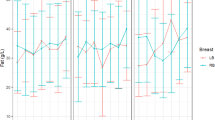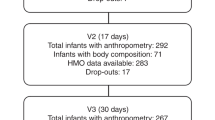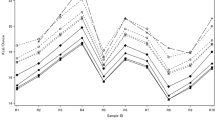Abstract
Objective:
Little is known about the effect of maternal handedness and preferential side of breastfeeding upon macronutrients concentration in human milk (HM). We aimed to compare macronutrients content of HM from both breasts, taking into account the self-reported preferential feeding ('dominant') breast, breast size and handedness (right versus left). We tested the null hypothesis that macronutrients content of HM is not affected by breast dominancy, breast size or maternal handedness.
Study Design:
Fifty-seven lactating mothers were recruited. HM macronutrients were measured after mid manual expression using infrared transmission spectroscopy.
Results:
Out of the 57 mothers recruited, 12 were excluded from the analyses because they brought in insufficient samples. Among the 22 who reported a size difference, 16 (73%) had a larger left breast (P<0.001). Approximately a third of women reported no breastfeeding side dominance, a third reported a right dominance and another third reported a left dominance. Breastfeeding side dominance was unaffected by either handedness or breasts size. When size asymmetry was reported (n=22) the dominant side was also the larger breast in 16 (73%) women, the smaller breast in 2 (9%) women, whereas 4 (18%) additional women with asymmetry had no preferential breastfeeding side. There were no statistically significant differences in macronutrients between the right and the left breasts. In multiple stepwise backward regression analysis, fat, carbohydrate, protein and energy contents were unaffected by maternal handedness, breast side dominance or breast size asymmetry.
Conclusions:
Macronutrients content of mid expression HM is unaffected by maternal handedness, breast size or breast side dominance.
This is a preview of subscription content, access via your institution
Access options
Subscribe to this journal
Receive 12 print issues and online access
$259.00 per year
only $21.58 per issue
Buy this article
- Purchase on Springer Link
- Instant access to full article PDF
Prices may be subject to local taxes which are calculated during checkout

Similar content being viewed by others
References
Harzer G, Haug M, Dieterich I, Gentner PR . Changing patterns of human milk lipids in the course of the lactation and during the day. Am J Clin Nutr 1983; 37: 612–621.
Mitoulas LR, Kent JC, Cox DB, Owens RA, Sherriff JL, Hartmann PE . Variation in fat, lactose and protein in human milk over 24h and throughout the first year of lactation. Br J Nutr 2002; 88: 29–37.
Lubetzky R, Littner Y, Mimouni FB, Dollberg S, Mandel D . Circadian variations in fat content of expressed breast milk from mothers of preterm infants. J Am Coll Nutr 2006; 25: 151–154.
Lubetzky R, Mimouni FB, Dollberg S, Salomon M, Mandel D . Consistent circadian variations in creamatocrit over the first 7 weeks of lactation: a longitudinal study. Breastfeed Med 2007; 2: 15–18.
Mandel D, Lubetzky R, Dollberg S, Barak S, Mimouni FB . Fat and energy contents of expressed human breast milk in prolonged lactation. Pediatrics 2005; 116: e432–e435.
Hausman Kedem M, Mandel D, Domani KA, Murase M, Mukai Y, Itabashi K et al. The effect of advanced maternal age upon human milk fat content. Breastfeed Med 2013; 8: 116–119.
Lubetzky R, Sever O, Mimouni FB, Mandel D . Human milk macronutrients content: effect of advanced maternal age. Breastfeed Med 2015; 10: 433–436.
Kent JC, Mitoulas LR, Cregan MD, Ramsay DT, Doherty DA, Hartmann PE . Volume and frequency of breastfeedings and fat content of breast milk throughout the day. Pediatrics 2006; 117: e387–e395.
Cox DB, Owens RA, Hartmann PE . Blood and milk prolactin and the rate of milk synthesis in women. Exp Physiol 1996; 81: 1007–1020.
Lev HM, Ovental A, Mandel D, Mimouni FB, Marom R, Lubetzky R . Major losses of fat, carbohydrates and energy content of preterm human milk frozen at −80 °C. J Perinatol 2014; 34: 396–398.
García-Lara NR, Escuder-Vieco D, García-Algar O, De la Cruz J, Lora D, Pallás-Alonso C . Effect of freezing time on macronutrients and energy content of breastmilk. Breastfeed Med 2012; 7: 295–301.
Mizuno K, Nishida Y, Taki M, Mimouni FB, Shay V, Marom R et al. Is increased fat content of hindmilk due to the size or the number of milk fat globules? Int Breastfeed J 2009; 16, 4:7 116–119.
Author information
Authors and Affiliations
Corresponding author
Ethics declarations
Competing interests
The authors declare no conflict of interest.
Rights and permissions
About this article
Cite this article
Pines, N., Mandel, D., Mimouni, F. et al. The effect of between-breast differences on human milk macronutrients content. J Perinatol 36, 549–551 (2016). https://doi.org/10.1038/jp.2016.17
Received:
Revised:
Accepted:
Published:
Issue Date:
DOI: https://doi.org/10.1038/jp.2016.17
This article is cited by
-
Influence of different breast expression techniques on human colostrum macronutrient concentrations
Journal of Perinatology (2021)
-
Daily variation of macronutrient concentrations in mature human milk over 3 weeks
Scientific Reports (2021)
-
The effect of donor human milk on the length of hospital stay in very low birthweight infants: a systematic review and meta-analysis
International Breastfeeding Journal (2020)
-
The effect of gestational diabetes mellitus on human milk macronutrients content
Journal of Perinatology (2019)
-
Feasibility of Standardized Human Milk Collection in Neonatal Care Units
Scientific Reports (2019)



